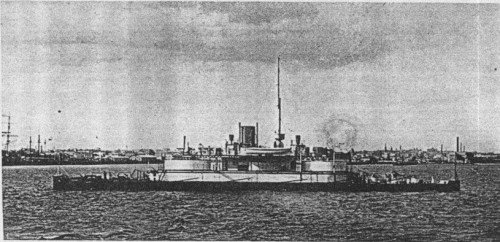
NAVYPEDIA
 Support the project with paypal
Support the project with paypal
Photo

Cerberus at Williamstown
Ships
Name |
No |
Yard No | Builder |
Laid down |
Launched |
Comp |
Fate |
|---|---|---|---|---|---|---|---|
| Cerberus (Victorian Navy) | Palmers, Jarrow, UK | 1.9.1867 | 2.12.1868 | 5.5.1870 | hulk 1900 |
Technical data
| Displacement normal, t | 3344 |
|---|---|
| Displacement full, t | |
| Length, m | 68.6 pp |
| Breadth, m | 13.7 |
| Draught, m | 4.67 |
| No of shafts | 2 |
| Machinery | 2 Maudslay 2-cyl HRCR, boilers |
| Power, h. p. | 1360 |
| Max speed, kts | 9.8 |
| Fuel, t | coal 120 |
| Endurance, nm(kts) | |
| Armour, mm | iron; belt: 203 - 152 with 279mm wood backing, breastwork: 229 - 203, turrets: 254 - 229, deck: 38 - 25 |
| Armament | 2 x 2 - 254/15 MLR Mk I/II |
| Complement | 155 |
Graphics
Project history
Low freeboard breastwork monitors intended for service as colonial coast defence ships. Designed by Reed for service at Melbourne (Cerberus) and Bombay (Magdala), they represent the beginnings of practical turret ship design in Britain, having no sail power and being fitted with fore and aft turrets with almost uninterrupted arcs of fire. Turrets were hand operated. Ships had twin screws and balanced rudders and manoeuvred well. Both ships were given a three-masted sailing rig for passage to their respective colonial ports which was removed on arrival. Cerberus had a pole mast abaft and Magdala a pole mast before the funnel. The flying deck originally overlapped the turrets but in Magdala it was cut back to the length of the superstructure.
Ship protection
The hull was protected by 203mm belt reducing to 152mm at the ends, and the turrets were raised on a central armoured breastwork 229mm at the ends and 203mm amidships. The breastwork served to keep the turrets, hatchways, vents and funnels, comparatively clear of the water, making the ships more practical in a seaway the the low freeboard contemporary ships of the US Navy. Turrets had 254mm faces and 229mm walls.
Modernizations
None.
Naval service
Cerberus was hulked in 1900, became depot ship Platypus II in 1918 and sold to BU 23.4.1924. She was sunk at Melbourne as breakwater in July 1926, but raised in 1978 and reconstructed as memorial.
 HOME
HOME FIGHTING SHIPS OF THE WORLD
FIGHTING SHIPS OF THE WORLD AUSTRALIA
AUSTRALIA CAPITAL SHIPS AND MONITORS
CAPITAL SHIPS AND MONITORS CERBERUS coast defence monitor (1870)
CERBERUS coast defence monitor (1870)
